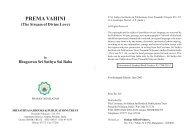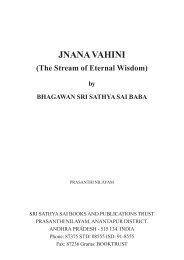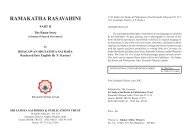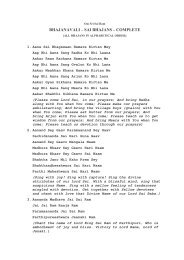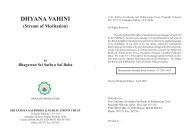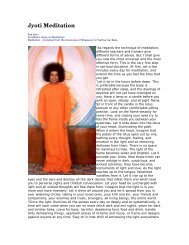UPANISHAD VAHINI - Sathya Sai Speaks
UPANISHAD VAHINI - Sathya Sai Speaks
UPANISHAD VAHINI - Sathya Sai Speaks
- No tags were found...
Create successful ePaper yourself
Turn your PDF publications into a flip-book with our unique Google optimized e-Paper software.
<strong>UPANISHAD</strong> <strong>VAHINI</strong>89of Brahmam which have not these traits. That is to say,Brahmam is not to be confused with anything that is not<strong>Sathya</strong>m, Jnanam and Anantham. All that are limited bytime, space and objectivity are jada (inert), materialapparently different from Brahmam. The characteristicsof <strong>Sathya</strong>m, Jnanam, Anantham, help to differentiate anddistinguish from kindred and similar phenomena the realBrahmam. Whichever rupam a thing is determined to have,if that rupa is unchanged, then it is referred to as <strong>Sathya</strong>m.If that rupa undergoes change, then it is Asathyam.Modification is the sign of untruth. Absence ofmodification is the sign of Truth.Brahmam is <strong>Sathya</strong>m, that is to say, it has nomodifications. It is nithyam, it is unaffected by time. Allthat is not Brahmam—that is, Jagath, is subject to change.All objects are subject to the triple process of the intellect:known, the knower and knowledge. Hence, the intellector Buddhi is spoken of as a guha or cave, where thethreefold process resides.In the Taittiriya Brahmana as well as in thisUpanishad, Dharma too is treated elaborately. It has threeforms: Kamya, Naimittika, and Nithya. The Sastrasseldom command that Karma has to be pursued. Thereis no need to do so for Karma comes naturally to man.Kama (desire) is the prompter of such Karma and mangets various fruits thereby. The Sastras teach only the



